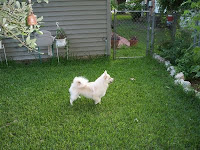At the end of every summer, I tear through every room and clean the house to the military standards of my childhood. My personal war against dirt requires vinegar, bleach, and Orange Oil. I break all of the attachments for the vacuum cleaner, gather my feather duster, and pull out the steam mop. I muster all of my energy as I attack each room for a floor to ceiling assault.
I don’t simply clean the rooms. Every drawer and closet receives personal scrutiny. I spend hours checking all the pens in the desks, sorting through papers scrunched into drawers, and make the executive decision: KEEP, GIVE AWAY, THROW-AWAY. As I sweep from room to room, I swap out knickknacks to freshen up an area. My teapot collection migrated from the kitchen into the family room several days ago. That movement means each pot goes through a thorough washing before finding a new perch. This assures everything gets cleaned.

My closet gets special attention during this offensive against dirt and clutter. I dump all my clothes onto the bed, a seemingly insurmountable mound, and begin the process of KEEP, GIVE AWAY, THROW-AWAY all over again. The clothing I keep, I check for missing buttons or pulled hems and take care of any small mending. I find an excellent movie on television, angle the ironing board in the perfect spot, and iron or press every item of clothing. My obsessive organizational oddities kick into full gear at this point. I don’t simply rehang my outfits into the closet. I decide on my strategy for order for the next few months and regulate my closet to that standard. Some years, my clothing becomes color and fabric coordinated. All red tops and blouses lined up neatly ranging from t-shirts to long sleeve silk. The blues, purples, whites, blacks all grouped neatly together. Following the tops are my skirts, then suits and finally pants. I organize them in this fashion because the floor of my closet has a cubby for organizing my shoes and I want clearance for easy access to that area. My shoes receive similar inspection as I decide to KEEP, GIVE AWAY, THROW-AWAY once again. I rotate summer flip-flops back into boxes, keeping out only one pair as I pull out dress sandals. All white shoes will shift back into boxes by Labor Day—another leftover rule of childhood. My deep cleaning stops only when I complete the garage. Then all of the items I’ve put into the donate pile get loaded into the car and taken to Goodwill.
Year after year, I’ve run through this drill as the last cleaning spree before I returned to school or work. I do a similar cleaning over the Christmas holidays because I’m redecorating every room, and a smaller raid through the house over Spring Break. This year, however, my cleaning strike appears more hit-n-miss. I started in the kitchen and family rooms instead of my bedroom. I haven’t opened a drawer or assailed my closet. At the end of last summer, the obsession to deep clean even though I wasn’t returning to work nagged me into my routine. The realization that I’m actually retired—and can do this type of cleaning anytime I want sank into my consciousness a few days ago. I don’t have to conquer my entire house within a few days. I know I won’t shake off the deep cleaning bug just because I’m retired, but I can select a different schedule than sweating out the August heat to clean the garage!















